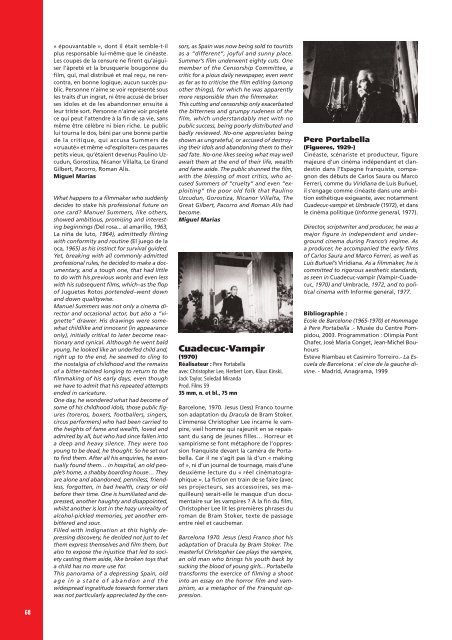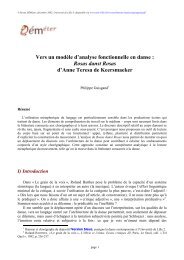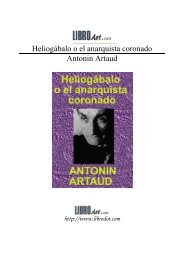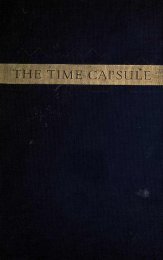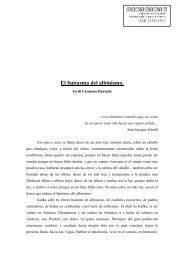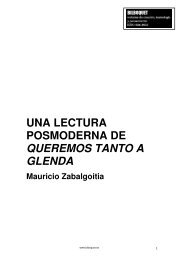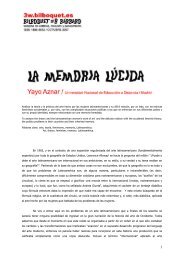« épouvantable », dont il était semble-t-ilplus responsable lui-même que le cinéaste.Les coupes de la censure ne firent qu’aiguiserl’âpreté et la brusquerie bougonne dufilm, qui, mal distribué et mal reçu, ne rencontra,en bonne logique, aucun succès public.Personne n’aime se voir représenté sousles traits d’un ingrat, ni être accusé de briserses idoles et de les abandonner ensuite àleur triste sort. Personne n’aime voir projetéce qui peut l’attendre à la fin de sa vie, sansmême être célèbre ni bien riche. Le publiclui tourna le dos, béni par une bonne partiede la critique, qui accusa Summers de«cruauté» et même «d’exploiter» ces pauvrespetits vieux, qu’étaient devenus Paulino Uzcudun,Gorostiza, Nicanor Villalta, Le GrandGilbert, Pa<strong>corr</strong>o, Roman Alís.Miguel MaríasWhat happens to a filmmaker who suddenlydecides to stake his professional future onone card? Manuel Summers, like others,showed ambitious, promising and interestingbeginnings (Del rosa... al amarillo, 1963,La niña de luto, 1964), admittedly flirtingwith conformity and routine (El juego de laoca, 1965) as his instinct for survival guided.Yet, breaking with all commonly admittedprofessional rules, he decided to make a documentary,and a tough one, that had littleto do with his previous works and even lesswith his subsequent films, which–as the flopof Juguetes Rotos portended–went downand down qualitywise.Manuel Summers was not only a cinema directorand occasional actor, but also a “vignette”drawer. His drawings were somewhatchildlike and innocent (in appearanceonly), initially critical to later become reactionaryand cynical. Although he went baldyoung, he looked like an underfed child and,right up to the end, he seemed to cling tothe nostalgia of childhood and the remainsof a bitter-tainted longing to return to thefilmmaking of his early days, even thoughwe have to admit that his repeated attemptsended in caricature.One day, he wondered what had become ofsome of his childhood idols, those public figures(toreros, boxers, footballers, singers,circus performers) who had been carried tothe heights of fame and wealth, loved andadmired by all, but who had since fallen intoa deep and heavy silence. They were tooyoung to be dead, he thought. So he set outto find them. After all his enquiries, he eventuallyfound them… in hospital, an old people’shome, a shabby boarding house… Theyare alone and abandoned, penniless, friendless,forgotten, in bad health, crazy or oldbefore their time. One is humiliated and depressed,another haughty and disappointed,whilst another is lost in the hazy unreality ofalcohol-pickled memories, yet another embitteredand sour.Filled with indignation at this highly depressingdiscovery, he decided not just to letthem express themselves and film them, butalso to expose the injustice that led to societycasting them aside, like broken toys thata child has no more use for.This panorama of a depressing Spain, oldage in a state of abandon and thewidespread ingratitude towards former starswas not particularly appreciated by the censors,as Spain was now being sold to touristsas a “different”, joyful and sunny place.Summer’s film underwent eighty cuts. Onemember of the Censorship Committee, acritic for a pious daily newspaper, even wentas far as to criticise the film editing (amongother things), for which he was apparentlymore responsible than the filmmaker.This cutting and censorship only exacerbatedthe bitterness and grumpy rudeness of thefilm, which understandably met with nopublic success, being poorly distributed andbadly reviewed. No-one appreciates beingshown as ungrateful, or accused of destroyingtheir idols and abandoning them to theirsad fate. No-one likes seeing what may wellawait them at the end of their life, wealthand fame aside. The public shunned the film,with the blessing of most critics, who accusedSummers of “cruelty” and even “exploiting”the poor old folk that PaulinoUzcudun, Gorostiza, Nicanor Villalta, TheGreat Gilbert, Pa<strong>corr</strong>o and Roman Alís hadbecome.Miguel MaríasCuadecuc-Vampir(1970)Réalisateur : Pere Portabellaavec Christopher Lee, Herbert Lom, Klaus Kinski,Jack Taylor, Soledad MirandaProd. Films 5935 mm, n. et bl., 75 mnBarcelone, 1970. Jesus (Jess) Franco tourneson adaptation du Dracula de Bram Stoker.L’immense Christopher Lee incarne le vampire,vieil homme qui rajeunit en se repaissantdu sang de jeunes filles… Horreur etvampirisme se font métaphore de l’oppressionfranquiste devant la caméra de Portabella.Car il ne s’agit pas là d’un « makingof », ni d’un journal de tournage, mais d’unedeuxième lecture du « réel cinématographique». La fiction en train de se faire (avecses projecteurs, ses accessoires, ses maquilleurs)serait-elle le masque d’un documentairesur les vampires ? A la fin du film,Christopher Lee lit les premières phrases duroman de Bram Stoker, texte de passageentre réel et cauchemar.Barcelona 1970. Jesus (Jess) Franco shot hisadaptation of Dracula by Bram Stoker. Themasterful Christopher Lee plays the vampire,an old man who brings his youth back bysucking the blood of young girls... Portabellatransforms the exercice of filming a shootinto an essay on the horror film and vampirism,as a metaphor of the Franquist oppression.Pere Portabella(Figueres, 1929-)Cinéaste, scénariste et producteur, figuremajeure d’un cinéma indépendant et clandestindans l’Espagne franquiste, compagnondes débuts de Carlos Saura ou MarcoFerreri, comme du Viridiana de Luis Buñuel,il s’engage comme cinéaste dans une ambitionesthétique exigeante, avec notammentCuadecuc-vampir et Umbracle (1972), et dansle cinéma politique (Informe general, 1977).Director, scriptwriter and producer, he was amajor figure in independent and undergroundcinema during Franco’s regime. Asa producer, he accompanied the early filmsof Carlos Saura and Marco Ferreri, as well asLuis Buñuel’s Viridiana. As a filmmaker, he iscommitted to rigorous aesthetic standards,as seen in Cuadecuc-vampir (Vampir-Cuadecuc,1970) and Umbracle, 1972, and to politicalcinema with Informe general, 1977.Bibliographie :Ecole de Barcelone (1965-1970) et Hommageà Pere Portabella .- Musée du Centre Pompidou,2003. Programmation : Olimpia PontChafer, José Maria Conget, Jean-Michel BouhoursEsteve Riambau et Casimiro Torreiro.- La Escuelade Barcelona : el cine de la gauche divine.- Madrid, Anagrama, 199968
Queridísimos verdugosGarrote Vil(1973)(Très chers bourreauxOur Beloved Executioners)Ecrit, réalisé et produit par : Basilio MartínPatino, en collaboration avec José Luis GarcíaSánchez, écrit d’après des textes de Daniel SueiroImage : Alfredo Fernandez Mayo, Augusto GarciaValbuena, Acácio de AlmeidaMontage : Eduardo Biurrún.Avec : Antonio López Sierra, Vicente Copeteet Bernardo Sánchez Bascuñana.Production : José María Gonsalez Sindepour Turner Films, Fondation Gulbenkian (Portugal)Distribution : La Linterna magicaFilm 35 mm, couleurs, 100 mnLes trois « exécuteurs » de l’Espagne franquisteracontent leur histoire, leur vision duterrible métier qu’ils exercent, tandis que lefilm enquête auprès d’experts et de documentssur la justice et la peine capitale enEspagne. Les récits des bourreaux se changenten témoignages sur la part la plussombre de l’humain, sur l’affreuse dimensionde l’obéissance, sur la terrible humanitédes « employés du garrot », reflets de lasociété qui les produit. “Le garrot est devenuune partie de ce qui est typiquementespagnol, comme les taureaux et le flamenco.”(commentaire du film).Three “executioners” from Franquist Spaintell their story and give their view of thegrim job they do, while the film inquires intojustice and capital punishment in Spain, usingexperts and documents. The executioners’stories document the darkest part of humankind, the horrific aspects of obedienceand the terrible humanity of these “employees”–areflection of the society that producedthem.“The garrotte has become part of what typifiesSpain, just like the bulls and the flamenco”(film commentary).Basilio Martín Patino(Salamanque, 1930-)Réalisateur de la génération du Nuevo Cine,fondateur de ciné-club, critique. Il participe àl’organisation des Conversations de Salamanqueen 1955 avant de rejoindre l’Ecolede cinéma de Madrid. Après son premier longmétrage, emblématique de la « nouvellevague » espagnole, Nueve cartas a Berta(1965), Patino subit fréquemment la censureet entame un parcours discret, longtempsclandestin, dans le cinéma de montage et ledocumentaire, en des réflexions sans compromissur la dictature et l’histoire, où la miseen fiction interroge constamment le réel. Onretiendra notamment : Canciones para despuésde una guerra (1971), Caudillo (1977),La Guerra civil española (1980), Los paraísosperdidos (1985), Madrid (1987), La Seduccióndel caos (1991, Fipa d’or en France), Andalucíaun siglo de fascinación (1996, série de 7films), Octavia (2002)A filmmaker of the New Spanish Cinema generation,a founder of film clubs and also acritic. He helped organise the 1955 SalamancaConference, before going on to join theMadrid Film School. After his first featurefilm, emblematic of the Spanish New Cinema,Nueve cartas a Berta (Nine Letters to Berta,1965), Patino was often censored and startedon an inconspicuous and long hidden activityin documentary filmmaking, with an uncompromisingapproach to dictatorship andhistory, where fiction constantly challengesreality. His main works include: Cancionespara despues de una guerra (1971), Caudillo(1977), La Guerra civil española (1980), Losparaisos perdidos (1985), Madrid (1987), LaSeduccion del caos (1991, Fipa d’or in France),Andalucia un siglo de fascinacion (1996, seriesof 7 films), Octavia (2002)Comme bien des films de Patino, et tantd’autres qui sortent des sentiers battus, le trèsironiquement intitulé Queridísimos verdugosnaît de la curiosité, d’une question.Tenter de découvrir - et si possible de comprendre- comment on peut être bourreau(sans compter les hypothèses proposées parLuis García Berlanga dans El Verdugo - LeBourreau, 1963) lance le cinéaste dans uneenquête dont la conclusion finit par se révélermoins importante que le cheminement.Localiser l’un des derniers bourreaux, peu actifen ses dernières années d’exercice, et lesoumettre à un interrogatoire, n’était pas uneentreprise facile, mais Patino la réussit brillamment,obtenant un portrait fascinant et inquiétant.Comme on pouvait s’en douter, ilfallut attendre la mort de Franco pour voirle résultat, sans pour autant que par la suite,et jusqu’à sa récente édition DVD, il ait étébeaucoup vu ou programmé à la télévision.Sans doute s’agit-il d’une œuvre dérangeante,à plus d’un sens, et pas seulement en raisondu métier de l’interviewé. La nature de l’interrogatoire(un peu à la manière des filmsde Marcel Ophuls ou de Claude Lanzmann)surprend aussi, ainsi que l’étonnante personnalitéqui émerge à la fin du film, peutêtrebien différente de ce qu’on pouvait attendre.C’est, de tous les filmssemi-documentaires de Patino, celui dans lequell’auteur intervient le moins, celui qu’illaisse le plus parler de lui-même.Il n’est pas nécessaire de faire un manifestecontre la peine de mort et le sinistre instrument(le garrot) des exécutions civiles : écouterles explications techniques du professionneldonne déjà le frisson.Miguel MaríasLike many of Patino’s films, and many othersthat are off the beaten track, the ironicallytitled Queridísimos verdugos springs out ofcuriosity and a question.It is the attempt to discover–and if possible tounderstand–what it means to be an executioner(aside from the hypotheses put forwardby Luis García Berlanga in El Verdugo–TheExecutioner, 1963) that launchesthe filmmaker into an inquiry where the conclusionturns out to be less important thanthe actual getting there.It was no easy task finding one of the last executioners,who in fact had little work towardsthe end of his career, and putting himthrough an interrogation, but Patino brilliantlysucceeds in producing a fascinatingand disturbing portrait. As could be expected,it was only after Franco’s death that the resultcould be viewed, and even since thenand right up to its recent DVD release, it hasseldom been seen or programmed on television.It is certainly a disquieting film in more sensethan one and not simply because of the interviewee’sjob. What is also surprising is thenature of the interrogation (not unlike thefilms of Marcel Ophuls or Claude Lanzmann),as well as the astonishing character thatcomes to light at the end of the film andwhich is perhaps very different from what wewould expect. Of all Patino’s semi-documentaries,it is the one in which the cineast leastintervenes and which most speaks for itself.No need for manifestos against the deathpenalty and the garotte, that grim instrumentused for civil executions. Merely listening tothe technical explanations of an expert isenough to make your hair stand on end.Miguel MaríasL’association Périphérie, le cinéma L’Ecran deSaint-Denis et Cinéma du réel s’associent pourun week-end de projections de films de BasilioMartin Patino, les 18, 19 et 20 mars 20<strong>05</strong>, ensa présence.The association Périphérie, L’Ecran film theatreat Saint-Denis and the Cinéma du réelare joining together on the weekend of 18,19 and 20 March 20<strong>05</strong> to screen the films ofBasilio Martin Patino’s, who will be present.69


